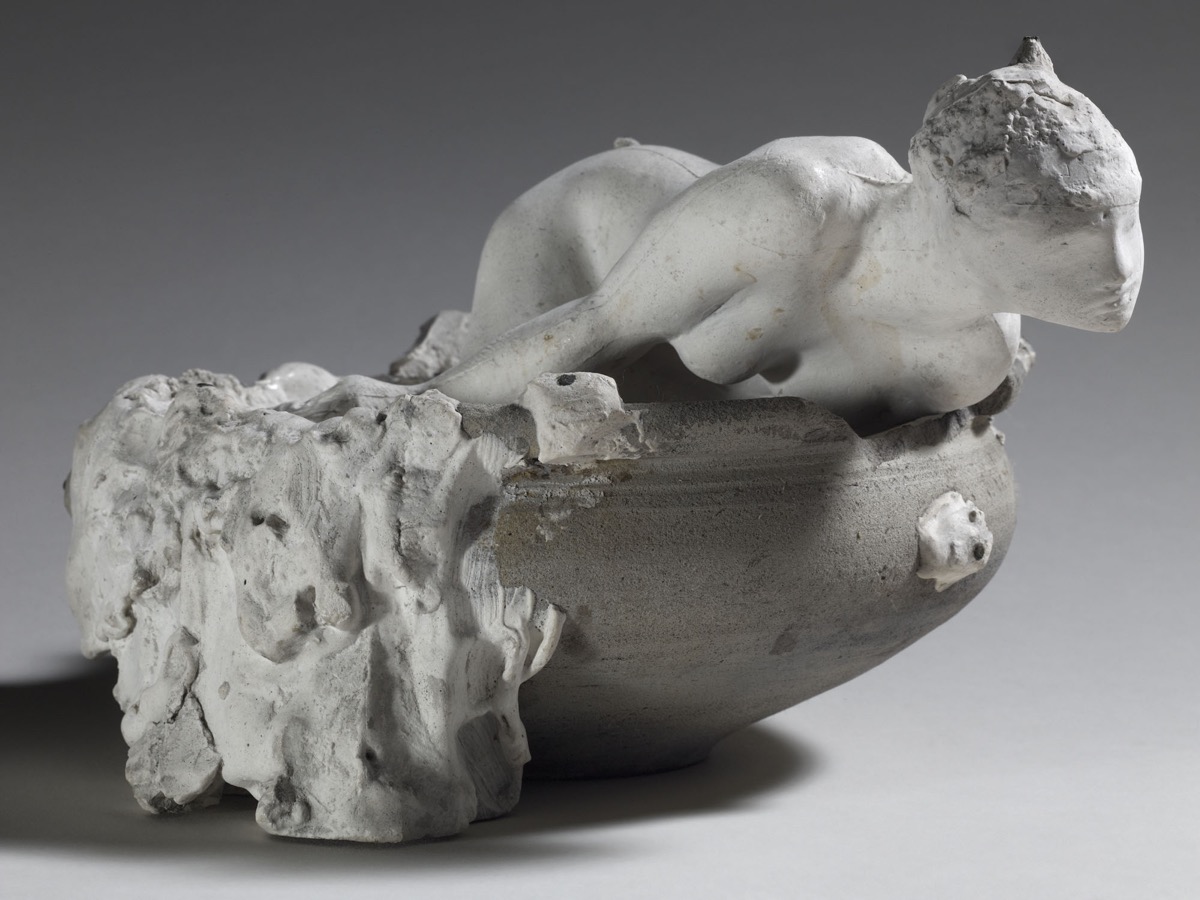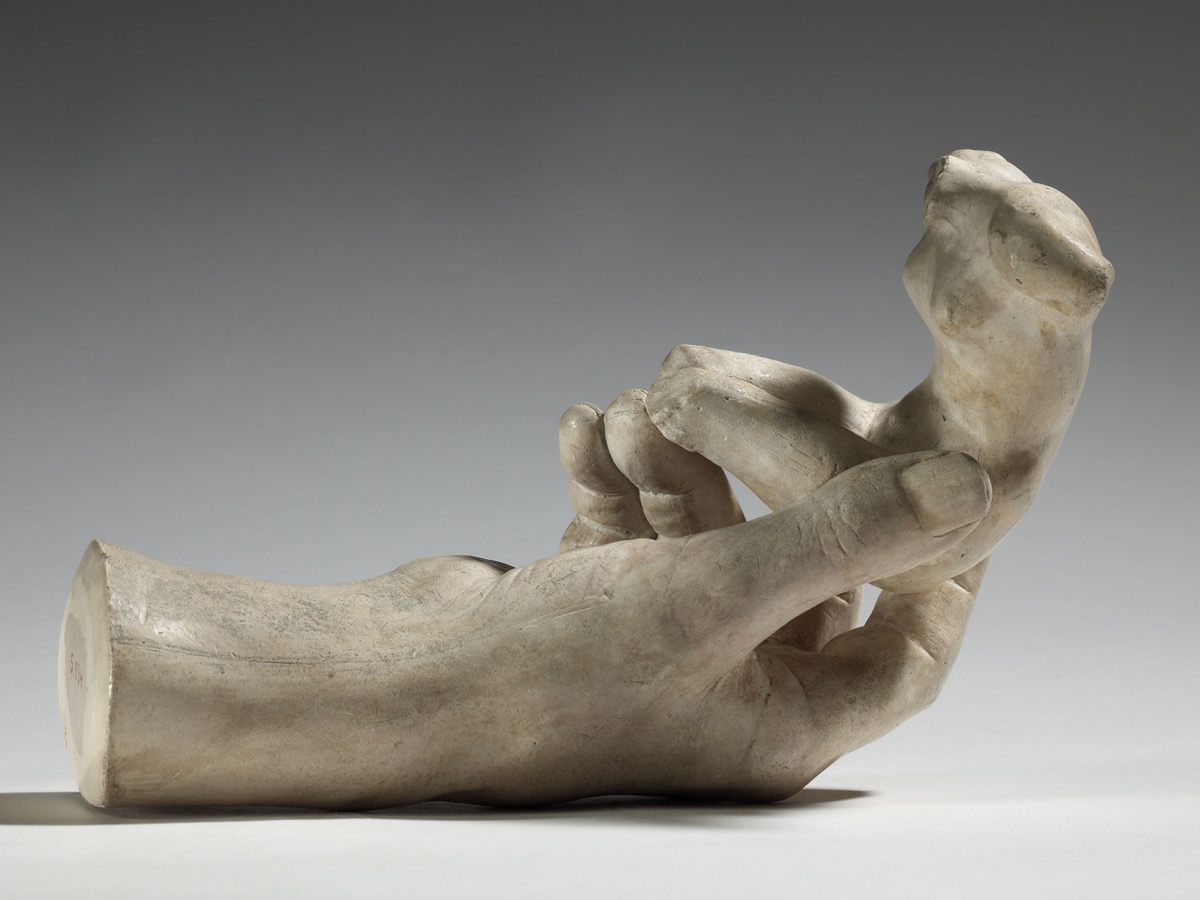The Horse I Rodin On: The evolution of a genius at the VMFA
David Shultz didn’t know a whole lot about Rodin, sculpture, or diseased hands. Now he knows, arguably, too much! (JK, just enough).

Auguste Rodin, Little Water Fairy (model), about 1903, plaster and terracotta. © Musée Rodin, photo by Christian Baraja
Justin Black is an art handler at the VMFA. When a piece of art needs moved, Justin and the crew are there to help. I had just snapped a photo of the beautiful staircase which leads from the museum to the parking deck, when I noticed Justin sitting on the porch outside the café. I decided to make my way over to where he was sitting. This is when he explained that, no, he wasn’t just basking in the morning light with a cup of coffee in a beautiful museum setting; he was actually at work. He had just spent the past 12 days installing the Rodin exhibit, in which I’d spent the previous hour.
The most difficult part of the installation was the marble section, according to Justin. Difficult, mainly, because marble is obscenely heavy. One piece weighed 2500 pounds, and nearly broke its designated table (which has since been reinforced). The bronze casts weren’t as heavy as the marble, and not as heavy as they look. Some tower over the room, but since they are hollow, were relatively easy to maneuver and set in place in comparison to the solid marble pieces. The rest of the exhibit was a fairly easy, and fun, installation for the art handlers. The plasters, the maquettes, the various sculpted body parts, the photographs, the sketches, “The Scream;” there was so much to consider and admire here. It must have been a joy to get to know these pieces as an art handler. Justin had the demeanor of someone who generally enjoys his work, and specifically enjoyed his time spent with this exhibit. “What a cool job,” I thought while a sentence or two trailed off between us. I then brought up what I considered my favorite part of the exhibit.
It’s about how Rodin worked, as much as the work itself. There is more than enough here to draw in and amuse any creatively inclined person. In certain parts, it all has the feel of an artist’s workshop. Works in progress sit alongside finished works. A miniature plaster version of a sculpture rests next to a 10-foot-tall augmented version. Many of the pieces aren’t complete. Often, the same work is displayed in different materials, or in different stages of completion. The process becomes tangible. It is an inspiring notion that any work, no matter who made it, started from nothing and likely underwent many revisions and reconsiderations.

Auguste Rodin, Molding of Auguste Rodin’s hand holding a torso, 1917, plaster. © Musée Rodin, photo by Christian Baraja
This focus on process is repeated over and again through the course of the exhibit, and leads one to many questions. For example, which of these is a finished piece? Are they are all finished because they all exist? What exactly was Rodin’s role in all of this? Why are there spikes coming out of that sculpture’s face? Why don’t I know what a maquette is?
Over 200 pieces are thoughtfully displayed, and the repetition of beauty is nearly numbing. It isn’t all beautiful though. For example, the series of Balzac sculptures, and in particular those featuring Balzac in a moment of creativity and/or self-pleasure. On first pass, this was the least pleasant series of works in the exhibit, but I’d ask you to Google “Rodin Balzac Penis” and tell me you don’t find whole story much more compelling.

Auguste Rodin, The Thinker (large-size model), 1903, patinated plaster. © Musée Rodin, photo by Christian Baraja
There is plenty of material here that one can learn to love, given the proper consideration. The best songwriters all have songs like that. Maybe Rodin’s study of potentially diseased hands will be my next “Think Too Much (a)”, which I didn’t grow to love until I gave it more of my attention.
This a celebration of hard work and curiosity; also talent, of course. But not all talented artists re-envision the potential of their medium and ceaselessly approach it in new ways. Not all talented artists employ over 50 people, could if they wanted to, or possibly would even consider it. In this, it’s pretty singular.
Throughout the many rooms of the exhibit, you’re not only able to view the ultimate product of Rodin’s talent, but you’re also invited to explore Rodin’s ideas as well as the very idea of Rodin. If your aim is to simply view and admire perfect and finished works in the setting of a gallery, you will find that, here, you are offered much more.
Rodin: Evolution of a Genius
- November 21, 2015 – March 13, 2016
- Virginia Museum of Fine Arts, 200 N. Boulevard
- Tickets are $15 for adults, $12 for seniors 65 , $10 for student – college, $10 for youth 7-17. Free for members, children 6 and under, active duty military and their immediate families.
Extras
The “Sculptor in Residence” Series, which doesn’t mean that Rodin is in residence, sorry. He’s been deceased for almost a century. Several contemporary and very much alive sculptors will work in the atrium and answer questions. Also on the demo table will be a variety of sculpting tools, and touchable samples of the three materials used in the exhibit: marble, bronze, and plaster.
Sculptor in Residence
November 20, 2015 – March 13, 2016 (except for Christmas and New Year’s Day)
Sundays: 11:00 AM – 1:00 PM
Wednesdays: 10:00 AM – 12:00 PM
Fridays: 5:00 – 7:00 PM
Assisted art-viewing, or just art without the actual viewing
In case you want to get a head start, or aren’t able to make it, here are the VMFA Audio Tours.
-
Recommend this
on Facebook -

Report an error
-

Subscribe to our
Weekly Digest




There are no reader comments. Add yours.